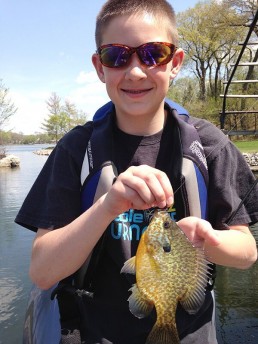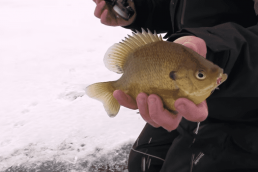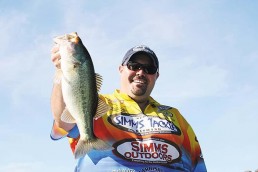Primary Panfish Tactics
SHARE THIS POST
The annual ice-out and changing of seasons from winter fishing to spring and summer fishing is a welcome occurrence each April. The arrival brings renewed anticipation, excitement and a time to venture back on the water—or shoreline—to make long casts and get reacquainted with the feel of a long fishing rod instead of a stubby winter stick. In the North, we benefit from a more pronounced change of seasons, and, I believe, more enthusiasm for a new year.
I always enjoy the steady afternoon bites encountered in April once any sheet of ice releases its grip on the surface. The mild weather so far in 2016 has virtually all types of fishing patterns in an accelerated mode. And we can do no wrong by accelerating likewise to our favorite panfish lake to enjoy a hot bite.
We’re blessed in the Twin Cities area with dozens of lakes to choose from that produce good fishing for pannies. I’ve never found it necessary to justify a spring outing by the numbers of giant panfish caught. For me, it’s all about the numbers and the ease with which these fish typically are hooked during spring. In recent years, traditional metro waterways where I cut my teeth in April and May are simply through casting a jig-n-crappie minnow beneath a float—these are proving grounds for “different ways to catch them.”
Modern angling technologies and techniques beget a perpetual experimentation, of sorts. And while a 1/32-ounce or 1/64-ounce jig with a Mylar nylon skirt (custom made by fellas like Bob Sonenstahl at Wayzata Bait), or the classic Cubby Jig or some other favorite “secret weapon.” (Anybody remember the original “Angle Jig” and it’s concave underbelly/deadly slow-fall wobble?) Then it’s tipped with a delicate crappie minnow that will always catch fish.
Isn’t it fun these days to approach spring panfishing with an arsenal of soft plastics, tungsten ice jigs re-purposed for open water, tiny spoons and the new wave of ultra-realistic, ultralight crankbaits?
I didn’t get my hands on Rapala’s new Ultra Light Pop last year until after the spring panfish frenzy had passed. I had good luck with these lures up north when the smallmouths got super-finicky during mayfly hatches, and a tiny surface disturbance was about the only thing that triggered their interest. Available in eight colors, including deadly incarnations designed to imitate small, injured minnows and frogs, the UL Pop promises to be ideal on those sunny, warm afternoons when the water is slick and sunnies in the shallows are suspending and rising to the surface. With polarized sunglasses you can see the hoards of fish basking in the sunshine like so many spring breakers. Every cast sends them scattering, only to recongregate and resume the ritual. When in this mood, pannies are gluttons for small surface poppers—I envy those flycasters.
Are you enjoying this post?
You can be among the first to get the latest info on where to go, what to use and how to use it!
Pick your favorite panfish jigs from the recent ice fishing season. Chances are, when you “retask” these choices underneath an open-water float balanced with a tiny split shot in line (if needed), you’ll load the boat with sunnies and crappies. I’ve already tied on VMC Tungsten Tubby Jigs, Wax Tails, Nymph Jigs and Boot Tails, because if any ice jig is paired with realistic, modern soft plastic trailers and you cast for spring panfish, you will excel. Soft plastics provide the added advantage of durability. When you’re catching fish on every cast, pausing to rebait with a live crappie minnow, it becomes a chore. Live bait always remains an option, especially on cloudy days or when cold fronts interrupt the steady bite. But with modern plastics, live bait is no longer is the only option.
To maximize enjoyment of spring panfish outings, try rigging up with some specialized gear. Certainly, you can use just about any rod and reel combo. After all, toddlers can have just as much success catching panfish on a Snoopy rod as their older siblings who are casting spinning gear. But, first and foremost, you should choose a light-action rod or ultralight rod for panfish purposes. Every April, the first open-water rods brought out are my St. Croix Avid Spinning 8-footers (AVS80MLM2), freshly spooled with 4-pound-test Sufix Elite mono on a Shimano Stradic. I originally migrated to super-long bobber rods during my early Mille Lacs days, first using St. Croix’s Wild River steelhead rods and eventually their 9-foot Avid (AVS90MF2) for rock-solid hook-sets on wind-blown walleyes.
A long bobber rod excels at making long casts with light line. And when the rod tip is raised, rapidly lifting the fishing line off the water’s surface for a rapid-line pick-up, especially when paired with a fast-ratio reel like the Stradic, is effective. Rig to battle panfish with the lightest gear you possibly can to enhance your enjoyment of catching modest sizes. (While light in the tip, these Avid rods still feature a healthy, firm, lower section that gives you a leg up when occasional hefty largemouths or pike nip your panfish lure.)
We’re all so busy these days; it’s harder than ever to justify full days on the water. Spring panfish offer us a reprieve. Just a few hours before or after work is all you need for fish-catching action that reminds you that spring is here.
MWO
SHARE THIS POST
Did you enjoy this post?
You can be among the first to get the latest info on where to go, what to use and how to use it!



